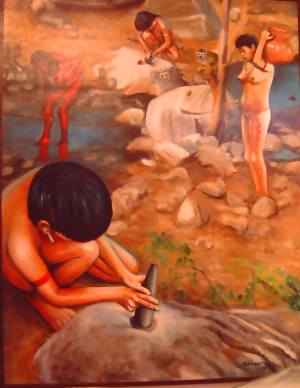Archaeological research during the past ten years confirms that the island's history predates the 15th Century Spanish conquest by several hundred years. The oldest known human settlement areas are located in the Northern part of the island, in the Grand Case lagoon plain. They consist of shell accumulations associated with remnants of rudimentary hewn stone tools, indicating passage of archaic Indian populations as early as 1800 BC These were hunter-fisher-gatherers, living in semi-nomadic groups, ignorant of pottery and agriculture.
The discovery of the Hope Estate site on a plateau overlooking the Grand Case plain brought evidence that the first ceramics were introduced on our island around 550 BC by groups originating from the Amazonian forest. These farming and pottery-making people came by canoe from the Orinoco delta and settled islands as far as the Greater Antilles. During this period they established a village on St. Martin which remained occupied until 650 AD This exceptionally rich site, under excavation for many years, has delivered numerous pottery adorned with paint, incisions and modeling, and ornaments carved from seashells and stone. Burial sites show evidence of certain rituals, the bodies put to rest in a fetal position and accompanied by offerings.
 Other villages would be settled later on the shores, as the population grew to be increasingly dependent on the marine environment, which became the major food source.
Other villages would be settled later on the shores, as the population grew to be increasingly dependent on the marine environment, which became the major food source.
Around thirty archaeological sites are catalogued on St. Martin, the most recent one, an Arawak village, discovered on a hillside near Baie Rouge. This settlement dates back to 1500AD The last indigenous populations of the Caribbean islands were decimated by the colonization process, some taken into slavery in the search for gold, others killed by the various diseases brought over from Europe. The Marigot Museum displays the best pieces discovered on the various digs in recent years. A visit there is a must for a thorough understanding of the island's pre-Columbian history.
Contacts:
Association Archeologique Hope Estate
Phone/Fax +590 29 22 84
Musee de Marigot
Phone/Fax +590 29 22 84
We thank NATURE Magazine for permission to republish this article.






